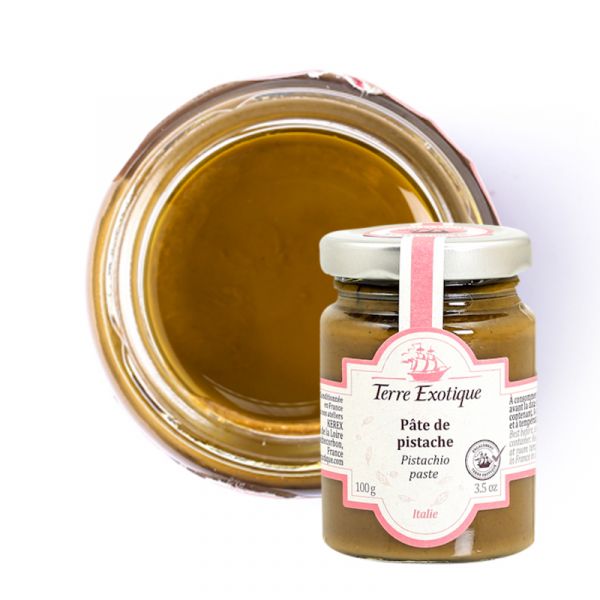





What Dishes to Use Pistachio Paste In?
Pistachio paste is an ingredient used in many sweet and savory dishes. In pastry, it is often incorporated into macarons, creams, icings, and desserts such as eclairs and tarts. It adds a delicate flavor and vibrant color to sweet preparations. On the savory side, pistachio paste is used to marinate meat, flavor sauces and dressings, and garnish fish or poultry dishes.
How to Use Pistachio Paste in Cooking?
Here are some recipe ideas for using pistachio paste in your cooking:
- - Pistachio paste cookies: In your usual cookie dough, replace some of the butter with pistachio paste and add white chocolate chips. Once baked, add a generous layer of pistachio paste on top of your cookies for extra indulgence.
- - Pistachio paste tagliatelle: Prepare your sauce by sautéing pistachio paste with butter and heavy cream in a small saucepan. Add your pasta and sprinkle with parmesan.
- - Pistachio paste panna cotta: While cooking your cream and milk, add pistachio paste and gelatin sheets. Blend everything, pour into glasses, and refrigerate.
- - Pistachio paste cupcakes: While making your cupcake batter, dilute pistachio paste in milk and incorporate it into the mixture. You can sprinkle pistachio powder on your frosting.
- - Apricot and pistachio paste clafoutis: In a bowl, mix all your ingredients and add pistachio paste diluted in milk. Spread apricots in the bottom of a buttered mold and pour the batter on top. Bake for 45 minutes.
- - Pistachio paste financier: Whisk your egg whites with granulated sugar and pistachio paste. Melt the butter and add it to the flour and almond meal. Pour the batter into molds and bake for 12 minutes.
What Is Pistachio Paste?
Pistachio paste is a preparation made from pistachios. To make it, pistachios are first selected for their quality, then peeled and ground until they turn into a smooth and thick paste. During the process, the natural oils present in pistachios are released, contributing to the smooth and creamy texture of the paste.
The Delicately Perfumed Aroma of Pistachio Paste
Pistachio paste has a distinctive aroma that is both rich, nutty, and slightly floral. It emanates a fresh and characteristic pistachio flavor with subtle almond notes. This unique aroma makes pistachio paste highly appreciated in cuisine, especially in pastry and confectionery, where it adds a delightful touch to a variety of desserts.
The Origin of Pistachios
Pistachios, or Pistacia vera, are a fruit tree belonging to the cashew family (Anacardiaceae). They have been cultivated for millennia for their delicious nuts. The pistachio tree is a small, evergreen tree that can reach a height of 3 to 10 meters. It has compound leaves and its fruits are drupes with hard shells containing the edible pistachio nut.
Pistachios are widely grown in Mediterranean regions, Central Asia, California (USA), and some parts of the Middle East. They are appreciated for their nutrient-rich and healthy fat-containing nuts, as well as for their use in various culinary preparations, including pistachio paste, desserts, savory dishes, and sauces. The pistachio tree is also valued for its high-quality wood, used in furniture and craftsmanship.
How Are Pistachios Cultivated?
Pistachios are grown in warm and dry climates, requiring abundant sunlight. Farmers typically plant both male and female trees to ensure cross-pollination and fruit production. Trees begin producing pistachios from their third or fourth year and reach full production after about 7 to 10 years. Pistachio harvest occurs once a year in late summer or early autumn. The nuts are then dried, hulled, and sorted before being ready for consumption.
The History of Pistachio Paste
The origin of pistachios dates back to Central Asia, where the pistachio tree, the nut-bearing tree, originated. Initially, this tree thrived in Northeastern Iran and Northern Afghanistan. Pistachios were highly prized by ancient civilizations such as the Mughals, Assyrians, and Persian royal families, highlighting their cultural and culinary significance.
| Price/kg | 104 |
|---|---|
| Allergen | Fruit à coque / Nut |
| Native country | NON UE |
| Ingredients | PISTACHIO (100%). |
| Nutritional Info | VN Energie pour 100 g (energy for 100g) : 2332 kJ / 557 kcal VN Matière grasse (fat) : 44.4 g Dont acide gras saturés (of which saturated fat) : 5.4 g VN Glucides (carbohydrate) : 27 g Dont sucres (of which sugars) : 7.6 g VN Protéines (protein) : 20.6 g Vn Sel (salt) : 0.025 g |
| Contenance | 100g |
| TRACES EVENTUELLES D'ALLERGÈNES | céleri, sésame, moutarde, fruits à coques. |
 Français
Français 





